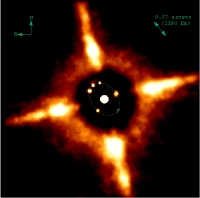Double asteroids and moons
This computer-processed image, taken in infrared light with the Canada-France-Hawaii Telescope on Mauna Kea, Hawaii, shows a small satellite, orbiting asteroid 45 Eugenia. This is the first asteroid satellite ever seen from the Earth.
A few asteroids have satellites that move around them in close orbits. The first to be discovered was 243 Ida and its moon, Dactyl, which orbits at a distance of 100 kilometres, seen by the Galileo space probe.
In 1999, an international team of astronomers discovered a moon orbiting 45 Eugenia. They estimated its diameter is about 13 kilometres (Eugenia's is 215 kilometres). The satellite has a circular, 5-day orbit, 1190 kilometres from Eugenia.
As well as these small moons, scientists have found an increasing number of asteroids to be 'doubles'. That is, two similarly sized asteroids that have drifted together gently and now orbit around each other, sometimes even touching, as they share a path around the Sun.
 Rock or rubble piles?
Rock or rubble piles?
Most asteroids are solid, indicating that they must have been molten at some point in their existence, later solidifying into their current shape. Others could be 'rubble piles', meaning that they are loose collections of 'pieces', held together by the force of their combined gravity.
A moon or a passing spacecraft allows us to determine the asteroid's mass because they can measure the asteroid's gravitational field. Such studies have shown that some asteroids are lightweights, only about twice the density of water, whereas rock has a density about three times greater than water.
It seems that these featherweight objects are either porous rubble piles of rock, or mostly made of water-ice. Rubble piles must have undergone numerous, severe collisions over thousands of millions of years. If the objects are largely ice, covered with a dark coating, they are extinct comets.

